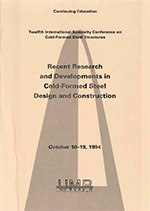Location
Saint Louis, Missouri
Session Dates
18 Oct 1994
Abstract
Codes of practice for the design of cold-formed sections have generally included a requirement for the coil material to possess a specified amount of ductility prior to forming. The scientific basis for such ductility requirements is shrouded in historical mystery but code drafting committees have been reluctant to remove these requirements in the absence of good reason. However, very low ductility steels have been used for the manufacture of cold-formed steel components for many years by the two leading UK manufacturers of storage racks without this lack of ductility giving rise to any problems during either manufacture or service. This relatively hard material is produced by taking conventional coil material and cold-reducing it prior to forming it into beam, column and other components. The advantage gained by this procedure is a significant increase in the yield stress but the penalty is a considerable reduction in the ductility. As, up to the present time, storage racking has not been subject to formal approval procedures, the absence of clauses in UK or European Codes of Practice allowing the use of these hard steels has not caused any problems. However, this situation is now changing and it has become necessary to justify their performance in comparison with material of more usual ductility. It may be noted here that the use of low ductility steel is not unique to storage racking because very hard steels have been also used successfully in Europe for the manufacture of profiled steel cladding. Galvanised coil is available with a guaranteed yield stress of 550 N/mm² and several manufacturers successfully form this material. Indeed, the first author has tested roof sheeting made from material which had a measured yield stress in excess of 700 N/mm² together with zero elongation in a conventional tensile test. The buckling-yielding failure modes observed in both single and two-span tests to failure showed no evidence of the influence of reduced ductility. In this paper, the justification for the use of low-yield stress steel is taken a stage further by describing a series of tests on racking components made from both cold-reduced steel and an equivalent hot-rolled steel of similar yield stress but much greater ductility. It is shown that the use of hard steel has no adverse effect on performance. The paper concludes by describing a test to failure of a full scale rack structure fabricated using components made from cold-reduced steel.
Department(s)
Civil, Architectural and Environmental Engineering
Research Center/Lab(s)
Wei-Wen Yu Center for Cold-Formed Steel Structures
Meeting Name
12th International Specialty Conference on Cold-Formed Steel Structures
Publisher
University of Missouri--Rolla
Document Version
Final Version
Rights
© 1994 University of Missouri--Rolla, All rights reserved.
Document Type
Article - Conference proceedings
File Type
text
Language
English
Recommended Citation
Cowen, J. S. and Davies, J. Michael, "Pallet Racking Using Cold-reduced Steel" (1994). CCFSS Proceedings of International Specialty Conference on Cold-Formed Steel Structures (1971 - 2018). 4.
https://scholarsmine.mst.edu/isccss/12iccfss/12iccfss-session10/4
Pallet Racking Using Cold-reduced Steel
Saint Louis, Missouri
Codes of practice for the design of cold-formed sections have generally included a requirement for the coil material to possess a specified amount of ductility prior to forming. The scientific basis for such ductility requirements is shrouded in historical mystery but code drafting committees have been reluctant to remove these requirements in the absence of good reason. However, very low ductility steels have been used for the manufacture of cold-formed steel components for many years by the two leading UK manufacturers of storage racks without this lack of ductility giving rise to any problems during either manufacture or service. This relatively hard material is produced by taking conventional coil material and cold-reducing it prior to forming it into beam, column and other components. The advantage gained by this procedure is a significant increase in the yield stress but the penalty is a considerable reduction in the ductility. As, up to the present time, storage racking has not been subject to formal approval procedures, the absence of clauses in UK or European Codes of Practice allowing the use of these hard steels has not caused any problems. However, this situation is now changing and it has become necessary to justify their performance in comparison with material of more usual ductility. It may be noted here that the use of low ductility steel is not unique to storage racking because very hard steels have been also used successfully in Europe for the manufacture of profiled steel cladding. Galvanised coil is available with a guaranteed yield stress of 550 N/mm² and several manufacturers successfully form this material. Indeed, the first author has tested roof sheeting made from material which had a measured yield stress in excess of 700 N/mm² together with zero elongation in a conventional tensile test. The buckling-yielding failure modes observed in both single and two-span tests to failure showed no evidence of the influence of reduced ductility. In this paper, the justification for the use of low-yield stress steel is taken a stage further by describing a series of tests on racking components made from both cold-reduced steel and an equivalent hot-rolled steel of similar yield stress but much greater ductility. It is shown that the use of hard steel has no adverse effect on performance. The paper concludes by describing a test to failure of a full scale rack structure fabricated using components made from cold-reduced steel.



